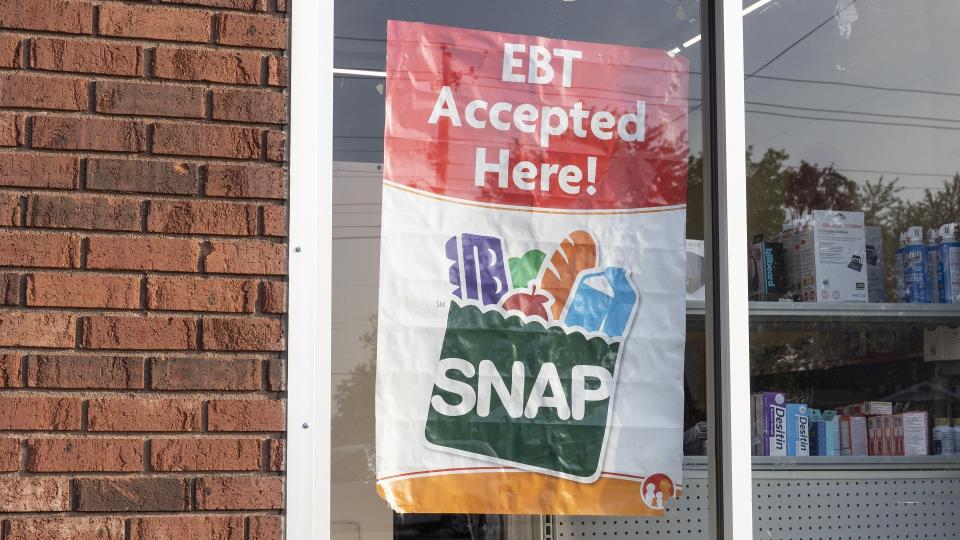Food Stamps: What To Do If You Lose Eligibility

More than 18 million Americans don’t have enough to eat at least some of the time in any given month, according to Pew Charitable Trusts, and more than 5 million frequently go hungry. Many of them can sum up their precarious situation like this: I make too much for food stamps, but can’t afford food.
Find Out: What Is the Highest Income for Food Stamps in 2022?
See: This Credit Score Mistake Could Be Costing Millions of Americans
About 41.23 million people in 21.61 million households rely on the Supplemental Nutrition Assistance Program (SNAP) to put food on their tables. But many more are shut out of the country’s largest anti-hunger initiative — formerly known as food stamps — by the program’s strict income limits.
If you’re one of the many Americans who exists in the limbo of earning too much to qualify for SNAP, but too little to pay for the food your family needs, you are not alone.
Here’s a look at the qualifications for SNAP, along with some of your other options.
What Are the SNAP Income Limits?
The following are the gross and net income limits for SNAP eligibility, based on household size, in the 48 contiguous states through Sept. 30. The thresholds are higher in Alaska and Hawaii.
1: $1,396 gross, $1,074 net
2: $1,888 gross, $1,452 net
3: $2,379 gross, $1,830 net
4: $2,871 gross, $2,209 net
5: $3,363 gross, $2,587 net
6: $3,855 gross, $2,965 net
7: $4,347 gross, $3,344 net
8: $4,839 gross, $3,722 net
Each additional person: +$492 gross, +$379 net
Income Is Part of the Issue, but Politics Also Plays a Role
At the start of the pandemic, Congress increased SNAP benefits by 15% and bumped all eligible recipients up to the maximum payment allowed for their household size. In 2021, the Biden administration increased the extra aid to at least $95 for every household.
Although the federal government funds it, the states administer SNAP. In states that rescinded their own emergency declarations, residents would no longer receive the enhanced benefits.
According to Pew, at least 16 states — all led by conservative opponents of the current administration — have opted out of the enhanced benefits.
Take Our Poll: Do You Think You Will Be Able To Retire at Age 65?
Federal SNAP Alternatives for Struggling Households
If you earn too much to qualify for SNAP, or if your state opted out of the enhanced benefits you need to avoid food insecurity, you might be eligible for one or more of these federal programs:
Special Supplemental Nutrition Program for Women, Infants, and Children (WIC): WIC provides supplemental food to low-income women who are pregnant, breastfeeding and non-breastfeeding postpartum. The program also provides food for infants, toddlers and children under five. More than 50% of the infants born in America receive help from WIC.
National School Breakfast and School Lunch programs: The National School Lunch and School Breakfast programs serve around 7.4 billion meals to schoolchildren from qualifying households at little or no cost every year.
Commodity Supplemental Food Program (CSFP): This program serves low-income seniors 60 and up by distributing food packages. The packages contain healthy USDA commodities, but they are not meant to provide a complete diet.
The Emergency Food Assistance Program (TEFAP): TEFAP provides temporary emergency assistance to households struggling with short-term food insecurity in partnership with local food banks.
Seniors Farmers’ Market Nutrition Program (SFMNP): SFMNP provides fresh food grown locally to more than 800,000 seniors.
Food Distribution Program on Indian Reservations (FDPIR): If you’re part of a low-income household on a reservation or other approved location, you might qualify for FDPIR.
USDA National Hunger Hotline: Call (866) 3-HUNGRY or (877) 8-HAMBRE for assistance in locating and connecting with meal distribution sites, food pantries and food banks.
Most Aid Comes From the State or Local Level
The USDA states that most of the nutrition assistance programs funded by the department’s Food and Nutrition Service are administered at the state and local levels. Visit the USDA Food and Nutrition Service’s Contact Map page to find your state’s available programs and all of their corresponding phone numbers, addresses, websites and other pertinent information.
You should also visit Feeding America, which is the country’s largest hunger-relief organization. A network of 200 food banks and 60,000 food pantries and meal programs, Feeding America serves nearly every community in all 50 states, Washington, D.C. and Puerto Rico. FeedingAmerica.org maintains a comprehensive database of local food banks that you can search by zip code.
Follow Food Shopping Best Practices
Whether you have an EBT card or not, you can save money at the grocery store by following the guidance most commonly cited by shopping and personal finance experts everywhere:
Sign up for your store’s rewards program
Pay with a grocery rewards card
Take the time to scour for both paper and digital coupons
Shop with a list and stick to it
Shop the sales
Buy generic or store brands
Use rebate, cash back or coupon apps like Fetch Rewards, Ibotta, Rakuten and Coupons.com
We hope this helps anyone out there struggling with food insecurity get the help they need.
More From GOBankingRates
This article originally appeared on GOBankingRates.com: Food Stamps: What To Do If You Lose Eligibility

 Yahoo Movies
Yahoo Movies 